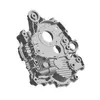Mobile:+86-311-808-126-83
Email:info@ydcastings.com
sand casting vs die casting
Sand Casting vs. Die Casting A Comparative Analysis
When it comes to metal casting techniques, two widely recognized methods are sand casting and die casting. Each method has its own unique advantages and disadvantages, making them suitable for different applications. Understanding the differences between these two processes can help manufacturers choose the appropriate method for their specific needs.
Overview of the Processes
Sand casting is one of the oldest and most versatile casting methods. It involves creating a mold from a mixture of sand, clay, and water. The sand is packed around a pattern to form a mold cavity. Once the mold is prepared, molten metal is poured into the cavity and allowed to solidify. After cooling, the mold is broken apart to retrieve the final cast part.
On the other hand, die casting is a more modern technique that involves injecting molten metal under high pressure into a metal mold, known as a die. The die is created to hold an intricate shape, allowing for high precision and consistency. Once the metal cools and solidifies, the die is opened, and the finished product is ejected.
Material Suitability
Sand casting is highly versatile in terms of the types of materials that can be used. It can handle ferrous and non-ferrous metals, including aluminum, bronze, brass, and iron. Due to the nature of the sand molds, sand casting is suitable for larger parts and complex geometries. Conversely, die casting is primarily used for non-ferrous metals such as zinc, aluminum, and magnesium. The materials used in die casting must have specific characteristics to withstand the high pressures involved in the process.
Production Volume and Cost Efficiency
sand casting vs die casting

One of the most significant differences between sand casting and die casting is the production volume and cost implications. Sand casting is generally more cost-effective for low to medium volumes. The cost of creating sand molds is relatively low, but the labor and time involved in producing each part can be higher. As a result, sand casting is often preferred for custom, one-off, or low-volume production runs.
Die casting, in contrast, is geared towards high-volume production. Although the initial investment for dies can be substantial, the rapid cycle times involved in the die casting process reduce labor costs and allow for mass production of components. This makes die casting the option of choice for industries that require large quantities of uniform parts, such as the automotive and consumer goods sectors.
Quality and Surface Finish
Regarding part quality and surface finish, die casting generally offers superior results. The high-pressure injection process creates tightly controlled dimensions and smoother surfaces, reducing the need for extensive post-processing. This precision makes die casting an ideal choice for components requiring tight tolerances.
On the other hand, sand casting may result in rougher surfaces and less precise dimensions, attracting more finishing work post-casting. However, the versatility of sand casting still proves beneficial for complex geometries and intricate designs that may be challenging to achieve with die casting.
Conclusion
In conclusion, the choice between sand casting and die casting largely depends on the specific requirements of the project at hand. Sand casting offers greater flexibility in terms of materials and complex shapes, making it suitable for low-volume productions or unique designs. Meanwhile, die casting excels in high-volume production, consistently delivering superior quality and precise tolerances. Manufacturers must weigh these factors carefully to select the most appropriate casting method for their needs, considering aspects like cost, volume, and design complexity. Ultimately, both sand casting and die casting play vital roles in diverse manufacturing sectors, demonstrating the enduring significance of these traditional yet evolving techniques in modern engineering.
-
Impeller Technology That Powers Precision in Pump SystemsNewsMay.22,2025
-
Valve Durability Begins with Quality Cast Iron ComponentsNewsMay.22,2025
-
Performance Cooling with Advanced Automobile Water Pump SolutionsNewsMay.22,2025
-
How Motor Housing and Oil Pans Shape Engine PerformanceNewsMay.22,2025
-
How Metal Castings Drive Modern Manufacturing EfficiencyNewsMay.22,2025
-
Exploring the Engineering Behind Valve Body CastingsNewsMay.22,2025











